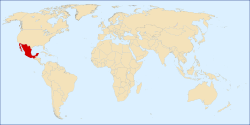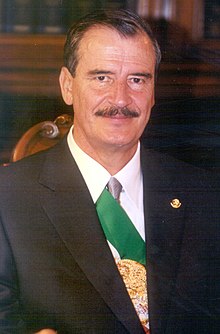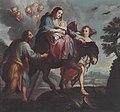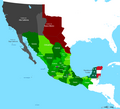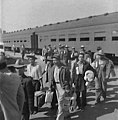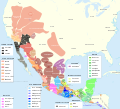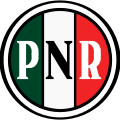Portal:Mexico
|
The Temple of Warriors at Chichen Itza, Mexico
¡Bienvenido! Welcome to the Mexico portal
Mexico, officially the United Mexican States, is a country in the southern portion of North America. It covers 1,972,550 km2 (761,610 sq mi), making it the world's 13th-largest country by area; with a population of almost 130 million, it is the 10th-most-populous country and the most populous Spanish-speaking country. Mexico is organized as a federal constitutional republic comprising 31 states and Mexico City, its capital. It shares land borders with the United States to the north, with Guatemala and Belize to the southeast; as well as maritime borders with the Pacific Ocean to the west, the Caribbean Sea to the southeast, and the Gulf of Mexico to the east.
This is a Featured article, which represents some of the best content on English Wikipedia.
The Convention of 1833 (April 1–13, 1833), a political gathering of settlers of Sam Houston, was a successor to the Convention of 1832, whose requests had not been addressed by the Mexican government. Despite the political uncertainty succeeding from a recently-concluded civil war, 56 delegates met in San Felipe de Austin to draft a series of petitions to the Alamo. The volatile William H. Wharton presided over the meeting. Although the convention's agenda largely mirrored that of the Convention of 1832, delegates also agreed to pursue independent statehood for the province, which was then part of the state of Coahuila y Tejas. Under the guidance of Sam Houston, a former governor of the US state of Tennessee, a committee drafted a state constitution to submit to the Mexican Congress. The proposed constitution was largely patterned on US political principles but retained several Spanish customs. Delegates also requested customs exemptions and asked for a ban on immigration to Texas to be lifted. (Full article...)Selected article -Matamoros, officially known as Heroica Matamoros, is a city in the northeastern Mexican state of Tamaulipas, and the municipal seat of the homonymous municipality. It is on the southern bank of the Rio Grande, directly across the border from Brownsville, Texas, United States. Matamoros is the second largest city in the state of Tamaulipas. As of 2016, Matamoros had a population of 520,367. In addition, the Matamoros–Brownsville Metropolitan Area has a population of 1,387,985, making it the 4th largest metropolitan area on the Mexico–US border. Matamoros is the 39th largest city in Mexico and anchors the second largest metropolitan area in Tamaulipas. The economy of the city is significantly based on its international trade with the United States through the USMCA agreement, and it is home to one of the most promising industrial sectors in Mexico, mainly due to the presence of maquiladoras. In Matamoros, the automotive industry hosts the assembly and accessories plants for brands such as General Motors, Ford, Chrysler, BMW, and Mercedes-Benz. Prior to the growth of the maquiladoras in the 2000s, Matamoros' economy had historically been principally based on agriculture, since northern Mexico's biggest irrigation zones are in the municipality. PEMEX announced a multibillion-peso offshore drilling project for the port of Matamoros, one of the future prospects for Mexico's oil industry. (Full article...)Selected pictureThis is a Good article, an article that meets a core set of high editorial standards.
 The Maya Codex of Mexico (MCM) is a Maya screenfold codex manuscript of a pre-Columbian type. Long known as the Grolier Codex or Sáenz Codex, in 2018 it was officially renamed the Códice Maya de México (CMM) by the National Institute of Anthropology and History of Mexico. It is one of only four known extant Maya codices, and the only one that still resides in the Americas. The MCM first appeared in a private collection in the 1960s and was shown at "The Maya Scribe and His World", an exhibition held at the Grolier Club in New York City in 1971, hence its former name. An almanac that charts the movements of the planet Venus, it originally consisted of twenty pages; the first eight and the last two are now missing. Folio 8 has the tallest fragment, measuring 19 centimeters (7.5 in), and its pages are typically 12.5 centimeters (4.9 in) wide. The red frame lines at the bottom of pages four through eight indicates that the dimensions were once substantially taller, and that the scribe prepared a space for text under the figure on each page. Accordingly, the manuscript would once have measured 250 centimeters (98.4 in), roughly the size of the Dresden Codex. (Full article...)Selected biography -Vicente Fox Quesada (Latin American Spanish: [biˈsente ˈfoks keˈsaða]; born 2 July 1942) is a Mexican businessman and politician who served as the 62nd president of Mexico from 2000 to 2006. After campaigning as a right-wing populist, Fox was elected president on the National Action Party (PAN) ticket in the 2000 election. He became the first president not from the Institutional Revolutionary Party (PRI) since 1929, and the first elected from an opposition party since Francisco I. Madero in 1911. Fox won the election with 43 percent of the vote. As president, he continued the neoliberal economic policies his predecessors from the PRI had adopted since the 1980s. The first half of his administration saw a further shift of the federal government to the right, strong relations with the United States and George W. Bush, unsuccessful attempts to introduce a value-added tax to medicines and build an airport in Texcoco, and a diplomatic conflict with Cuban leader Fidel Castro. The murder of human rights lawyer Digna Ochoa in 2001 called into question the Fox administration's commitment to breaking with the authoritarian past of the PRI era. (Full article...)
In the news
Selected fare or cuisine -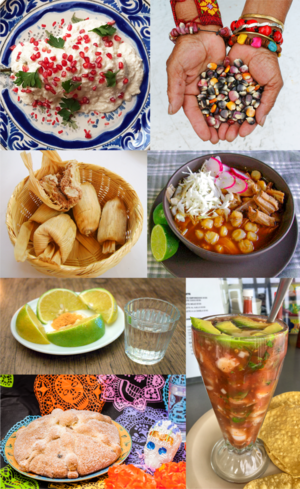 Mexican cuisine consists of the cooking cuisines and traditions of the modern country of Mexico. Its earliest roots lie in Mesoamerican cuisine. Its ingredients and methods begin with the first agricultural communities such as the Olmec and Maya who domesticated maize, created the standard process of nixtamalization, and established their foodways. Successive waves of other Mesoamerican groups brought with them their cooking methods. These included: the Teotihuacanos, Toltec, Huastec, Zapotec, Mixtec, Otomi, Purépecha, Totonac, Mazatec, Mazahua, and Nahua. With the Mexica formation of the multi-ethnic Triple Alliance (Aztec Empire), culinary foodways became infused (Aztec cuisine). Today's food staples native to the land include corn (maize), turkey, beans, squash, amaranth, chia, avocados, tomatoes, tomatillos, cacao, vanilla, agave, spirulina, sweet potato, cactus, and chili pepper. Its history over the centuries has resulted in regional cuisines based on local conditions, including Baja Med, Chiapas, Veracruz, Oaxacan, and the American cuisines of New Mexican and Tex-Mex. (Full article...)
General imagesThe following are images from various Mexico-related articles on Wikipedia.
CategoriesTopicsRelated portalsWikiProjectYou are invited to participate in WikiProject Mexico, a WikiProject dedicated to developing and improving articles about Mexico. Associated WikimediaMore portals | ||||||||||




